By Tom Modugno of Goleta History
Refugio State Beach is one of the true gems of the Gaviota Coast and a longtime local favorite.
Campers, fisherman, hikers and surfers all enjoy the peaceful solitude and refuge found there. The statuesque palm trees that line the cove give a distinctive and majestic look to the area.
Over the past few winters, those iconic palm trees have gotten closer and closer to the tide line, thanks to a severe lack of sand on the beach.
The much talked about El Nino of 2016 brought lots of pounding surf to our coastline but not much rain, further removing what little sand we had left. Add to that some extremely high tides, and the result was some severe damage to our coastline.
This has been a recipe for disaster for the Refugio palms. That winter, several of the old palms were washed out to sea, and many more are about to follow suit.
While most everyone agrees the palms are beautiful and and a landmark of the area, most folks have no idea how, when or why those palms got there. So here’s their story-
In the early 1900’s, Goleta pioneer Stephen Rutherford bought the Refugio property. It was a brushy, tree covered swamp until about 1920. Ranchers from the Santa Ynez Valley would drive their cattle over the Refugio Pass and stop at the beach for a rest before sending their beef off to be sold.
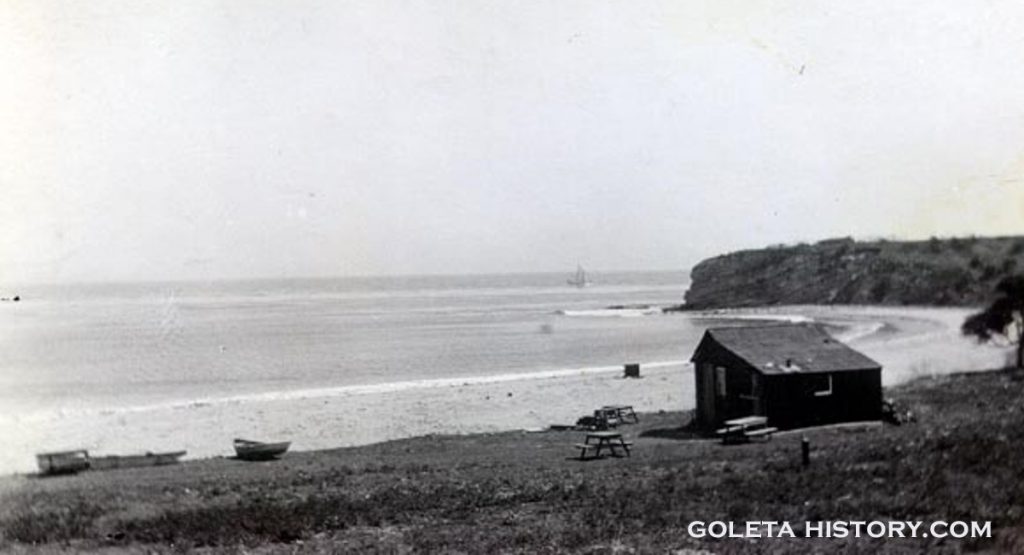
Other than that, there were just occasional fisherman and picnickers visiting the area.
Tired of paying the property tax on land he never used, Stephen Rutherford offered the property to Santa Barbara county for free, but they refused. Their response was, “there is lots of beach, but not many people”.
In the early 1920’s, automobiles were more prevalent and that brought more people up into the area. Refugio started to become a destination spot, and that’s when the state health officials got involved. They told the Rutherford family that if they were going to allow people to congregate on the beach, they needed to install restrooms. The Rutherfords said they didn’t invite the people, they just went there because it was free. They tried to dissuade the visitors by putting up a fence and a “No Trespassing” sign, but those were quickly torn down by the public.
The Rutherford’s neighbors convinced them they should build some facilities and charge admittance. Once they did, they realized they had something good going. Stephen Rutherford’s grandson, Nelson Rutherford took an interest in the new family business and he expanded the operations.
He brought in some rental boats, built a store, cabins and a small house, that are still being used today. It was around this time, estimated to be 1928, that Nelson Rutherford planted the palms at Refugio.
With the oil boom at Ellwood, geologists were drilling all up and down the coast. At Refugio, instead of oil, they found hot sulphur water. The Rutherfords built a concrete pool by the beach and the mineral bath was a big attraction. Every year the winter tides destroyed the pool, and for three straight years they rebuilt it.
Throughout the 1930’s, more landscaping was done and more structures were built, and more people came to the beach. Nelson kept the beach open from Memorial Day to Labor Day, and he charged 50 cents per car for day use and $1 per car to camp overnight. For another buck, you could get a barbecue dinner that included meat, beans and homemade ice cream. During the depression, a hobo would occasionally walk or ride into the park on a donkey and offer to trade a few hours of work for a hot lunch.
Nelson Rutherford ran the camp for years and dealt with things like wind, sunburns, health officials, and tar on the beach that guests would step in. Some campers had never seen the ocean before and wanted to set their tents up on the wet sand of a low tide. During prohibition, the Rutherfords heard about illegal rum-running on the beach, but they never caught anybody in the act. They would hear the dog barking like crazy, but by the time they got down there all they would see was tire tracks in the sand. Not much different than today’s pangas…
In 1942, a Japanese submarine shelled the Ellwood oil fields, and the coast of California was suddenly the western front of World War II. Shortly thereafter, the Army set up a radar unit at Refugio, and that shut down the thriving beach resort until 1946.
When the military unit pulled out, much of the resort had been damaged, and the Rutherfords weren’t sure if they wanted to continue running the campground. In the end, they decided to sell the property to the state for $105,000.
Refugio Beach Park continued to flourish as a popular get away spot, close to town, but far away from the world.
And when surfing became more popular, so did Refugio. How’s that for a parking space, eh?
The campground continued to grow to accommodate the growing crowds.
And through the years, as the crowds grew, so did Nelson’s palms.
Today, the campground is world famous, and campsites need to be reserved months in advance.

Nelson Rutherford’s palms make the cove at Refugio even more beautiful, and they give it a characteristic unique to the Gaviota Coast.
Many successful artists have been inspired by the palms in the cove, such as Tom DeWalt.
Chris Potter.
And Jeffrey Campbell.
So here we are today, nearly 100 years after these palms were planted, and they are now hanging in the balance.
It’s no longer a question of “if” they will all be washed away, it’s now a question of “when”.

These photos are from January 2016, when several of the palms were taken by the tide.
As onlookers watched, they drifted out to sea.
A noble burial at sea for an historic landmark, nearly a century old.
These palms are not hard to transplant, and Mother Nature has done most the work already, exposing the majority of the root ball. But in these days of budget cuts and deep deficits, the chance of these palms getting saved is slim to none.
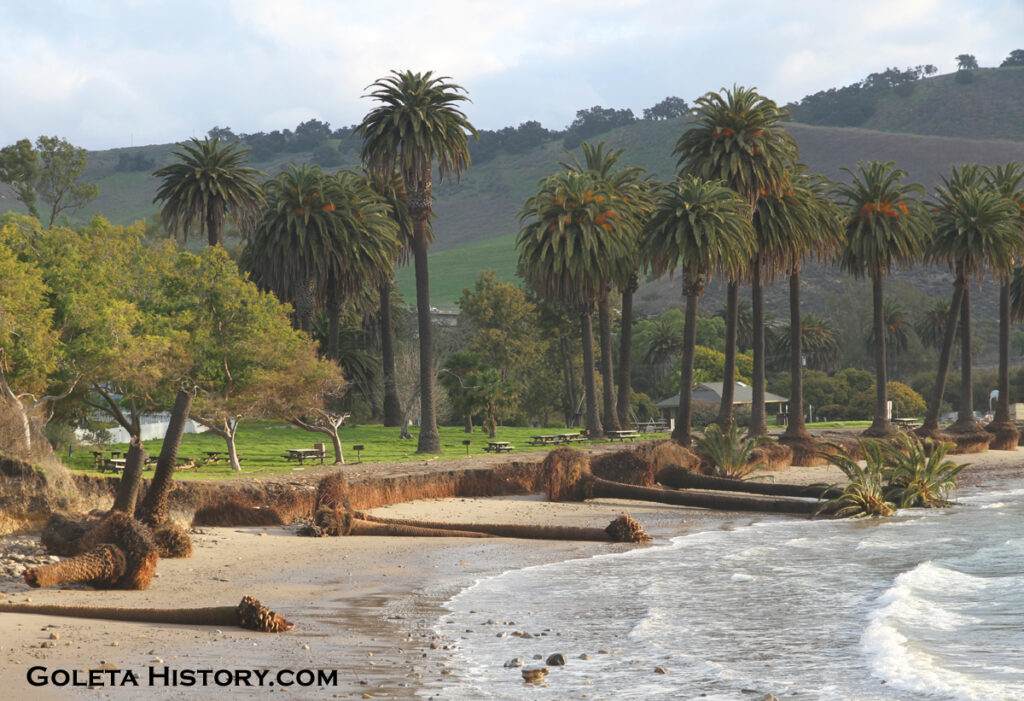
Fast forward to winter 2024. Several weeks of powerful swells and high tides have put the removal of Rutherford’s palms on fast forward.

The palms are dropping like flies.
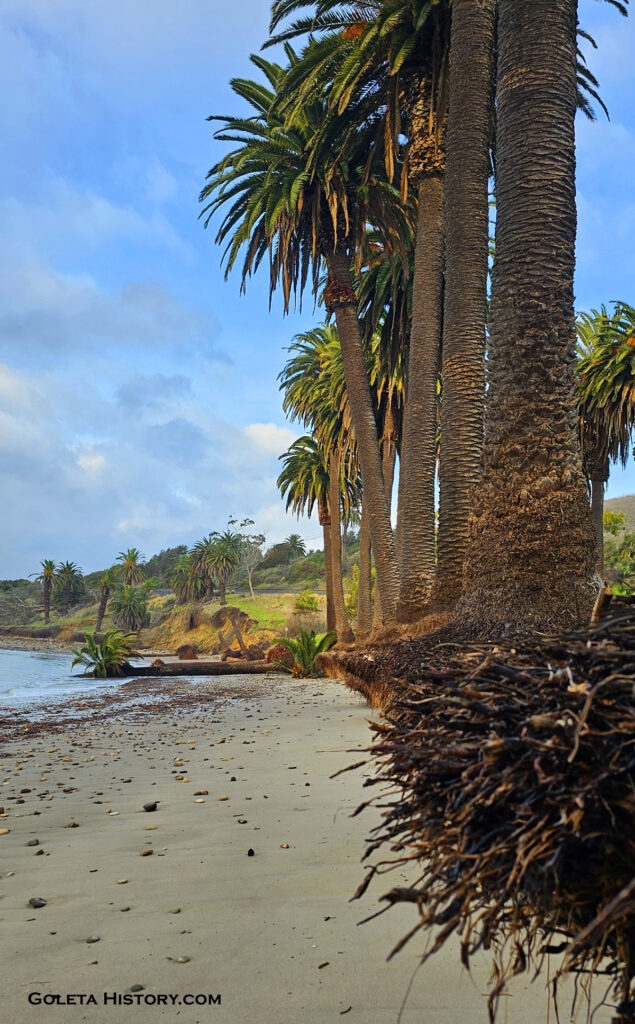
At the time of this writing, the park is closed for public safety reasons. Evidently a palm almost took out some visitors….
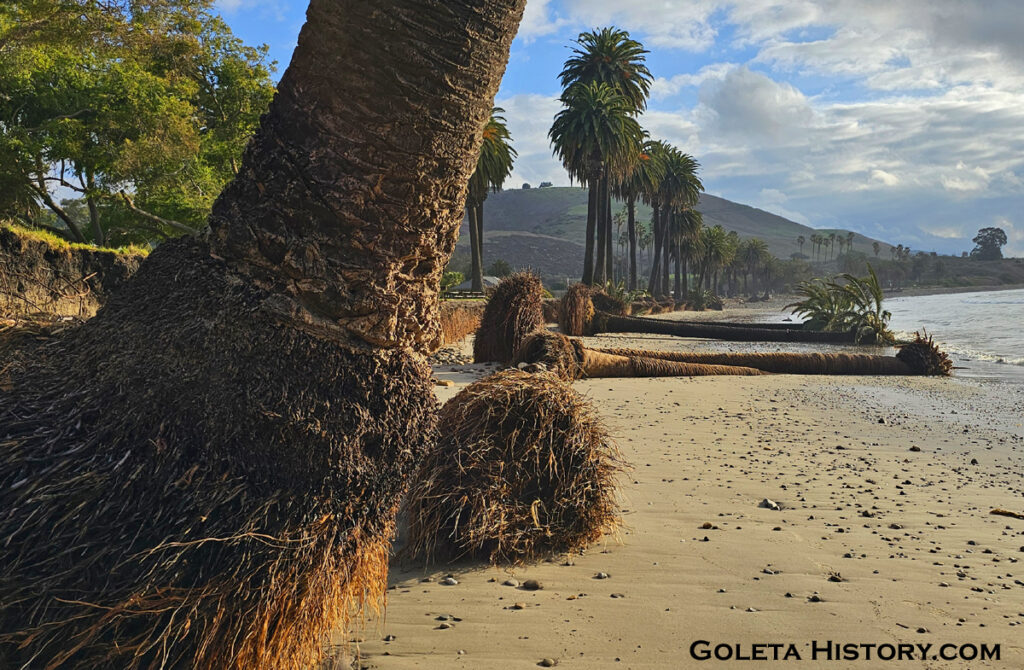
If you’ve just been here a couple times, or you just moved to the area, this is just Mother Nature doing what she does. Coastal erosion has been here as long as tar on the beach.
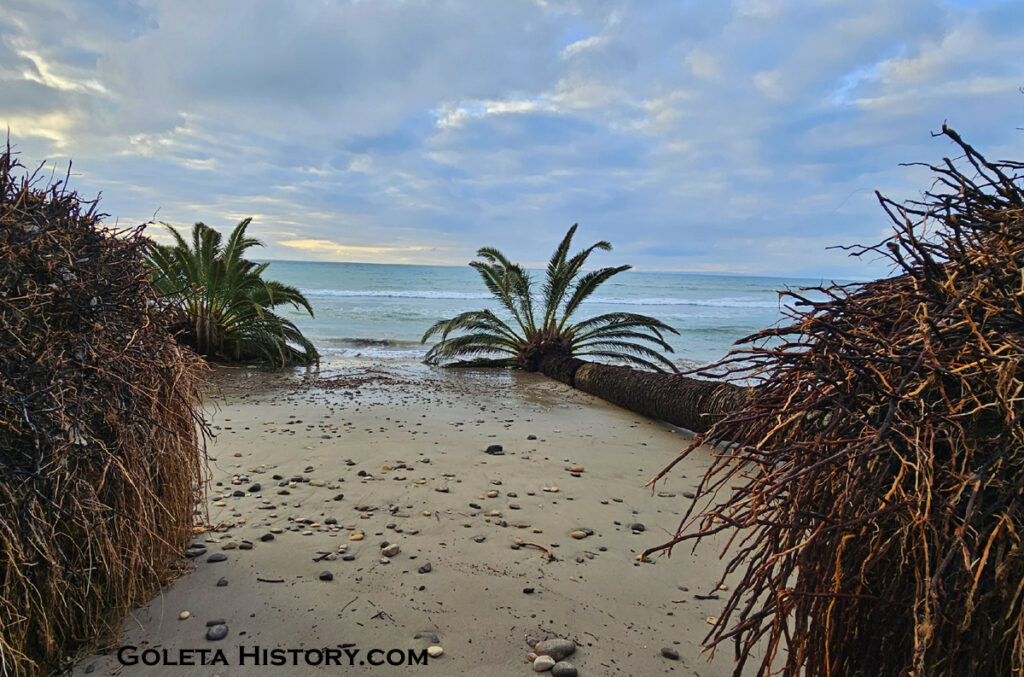
But if you’re a lifelong local that grew up with these trees, this is really sad.
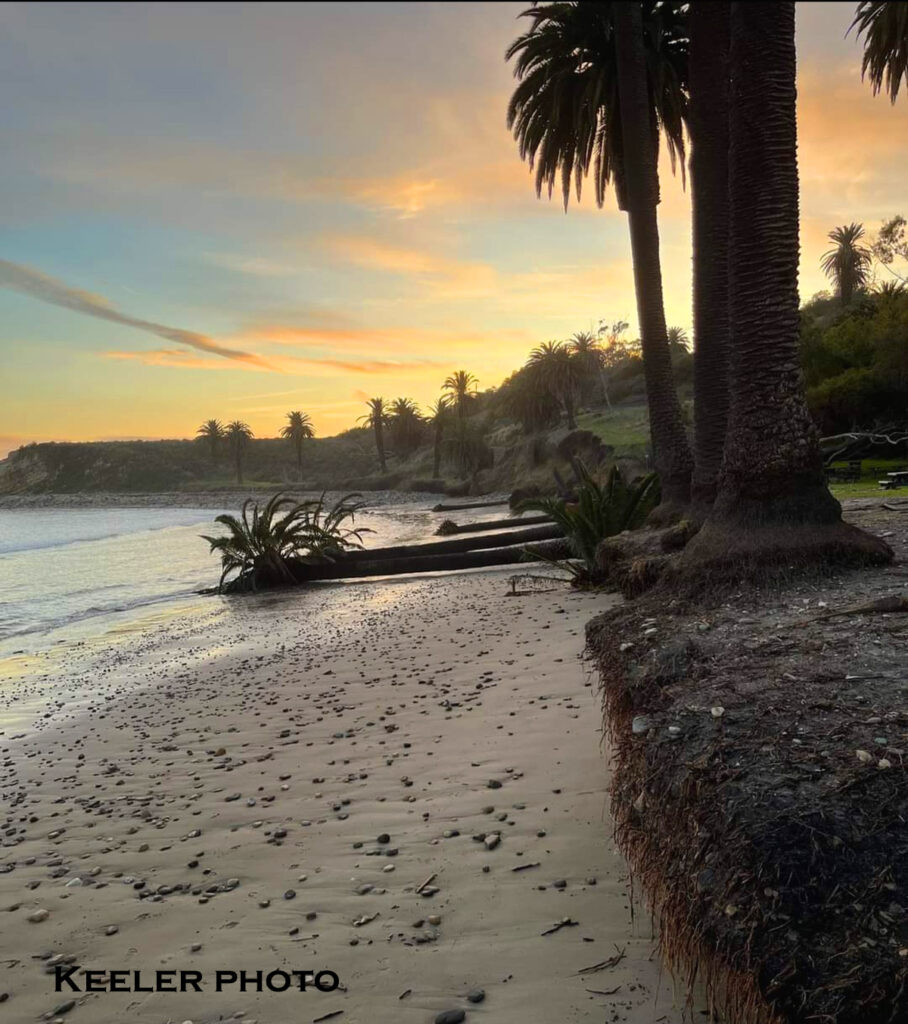
Countless summer days were spent in the shadows of these palms.
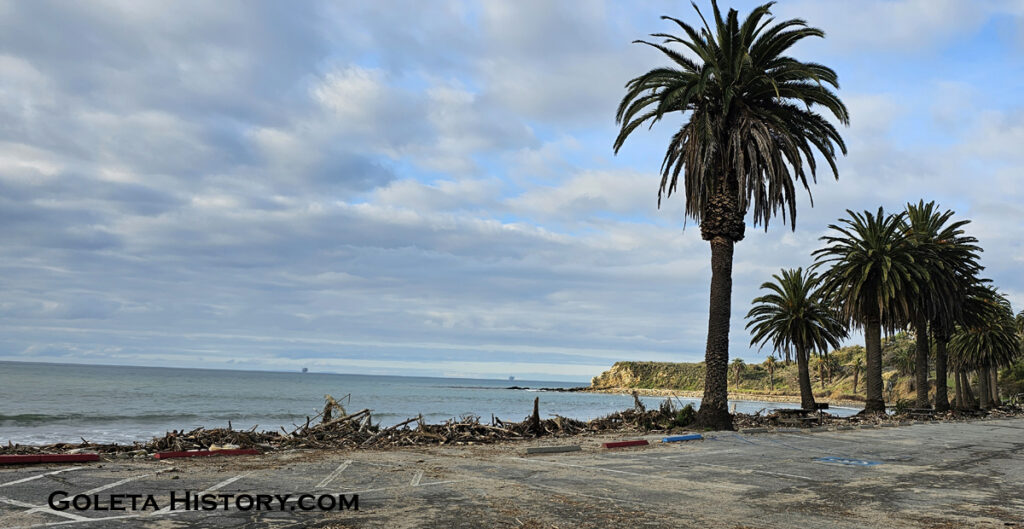
Now there’s a huge hole in the line up.
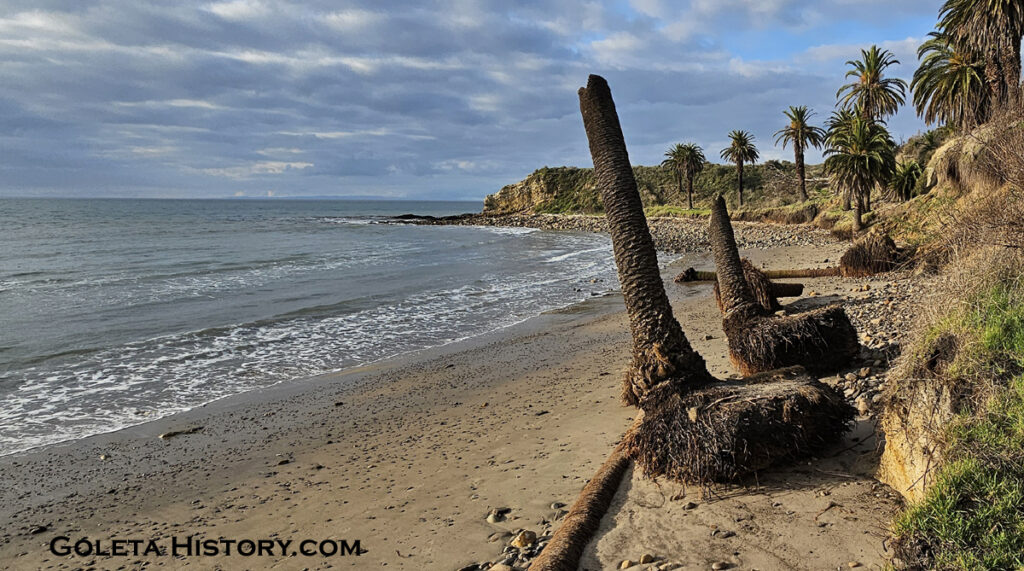

If you are a local history enthusiast, this is like watching the Ellwood Gas Station collapse, or the Original Two Hangars being torn down. A huge loss.
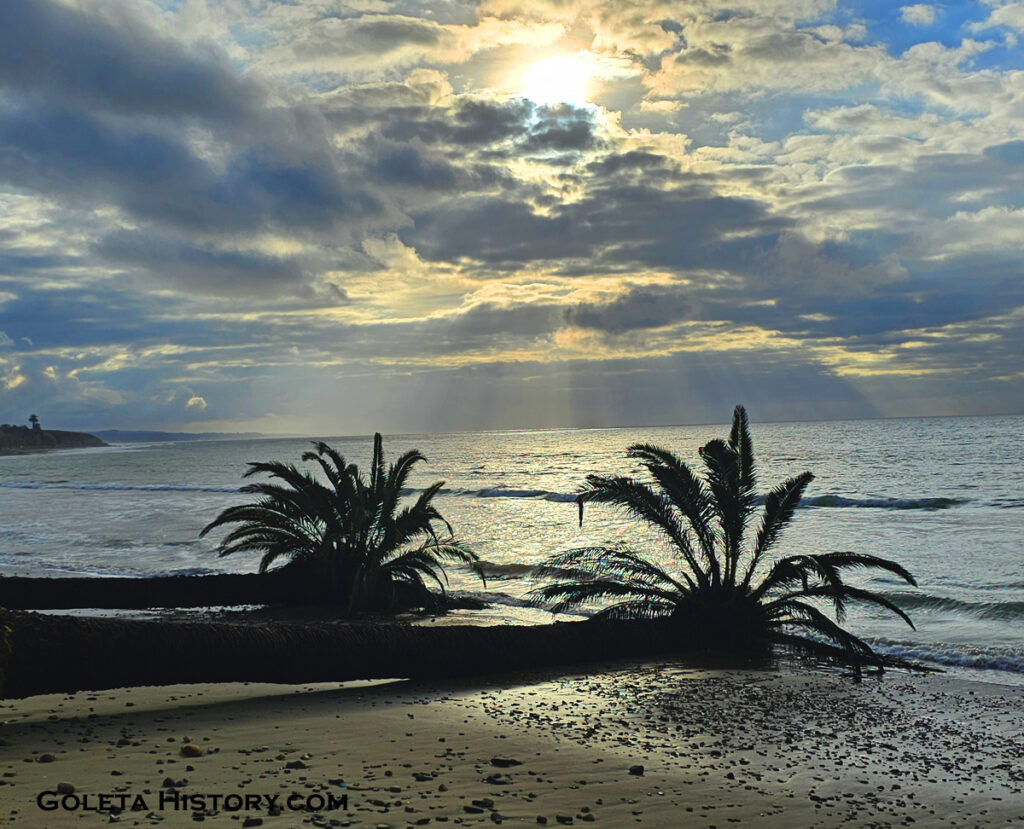
It is the end of a long and beautifully scenic part of Goleta history.
In February 2024, I spoke directly to a State official involved in planning for the State Parks and she said that they are very concerned about the loss of the iconic palms. And while the funds are an issue, the reality is, these amazing trees have already outlived their normal life expectancy. So even if they did move them, they probably wouldn’t last much longer.
She provided me with this official statement-
“Parks recognizes the importance of the Refugio Palm trees to both erosion control as well as the historic fabric of the park. Where armament and relocation of the trees is tempting, these specific specimens are at the end of their useful life being that a typical specimen is projected to last circa 50 years. Parks is in the early stages of evaluating the Refugio site and how to best adapt to impending impacts from sea level rise yet keep the historic landscape that is treasured. This year you should see an opportunity to contribute by public input to a planning effort for both the Gaviota and Refugio park lands; this is an integral first step to provide specific concerns and assist parks in planning for the future.”

So, the main reason for the state not to save the palms is that they have already outlived their “useful lives”. But several botanist friends and a quick Google search revealed that these Canary Island Date Palms live 200 to 300 years! They have a lot of years left in them. I went back to the state official I spoke with and she said she will have to get a new statement from the higher ups and get back to me…My official guess is the blame will go back to funding.
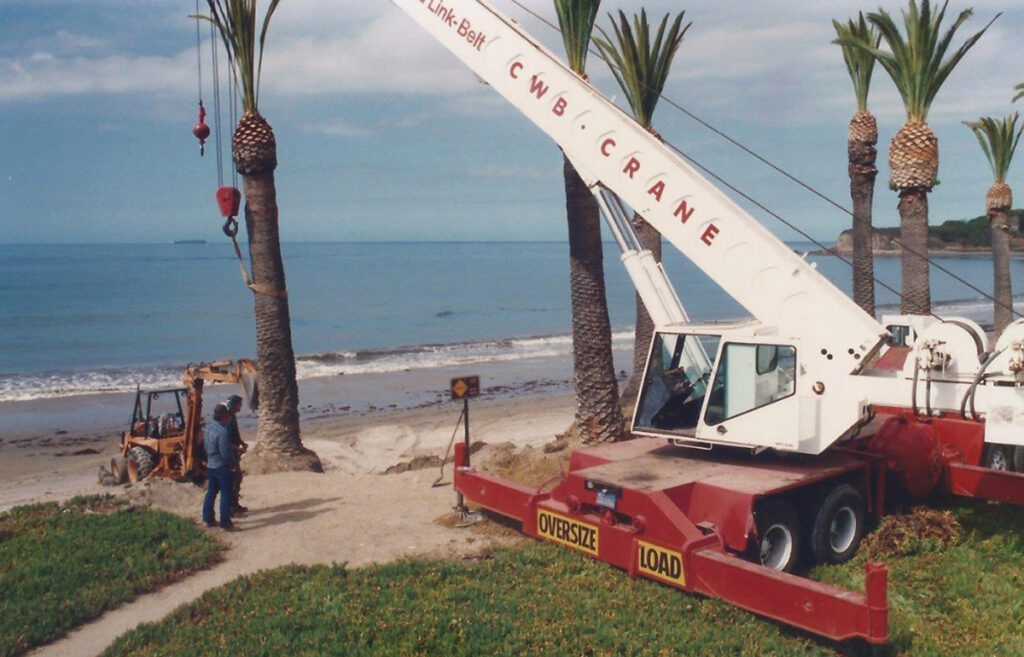
But they did it before, back in the 1990s. Why can’t they do it again?
If you think these palms should be transplanted in the park, send a letter telling them to Save The Refugio Palms –

Whatever “official” reason they come up with, the next problem will be the parking lot.
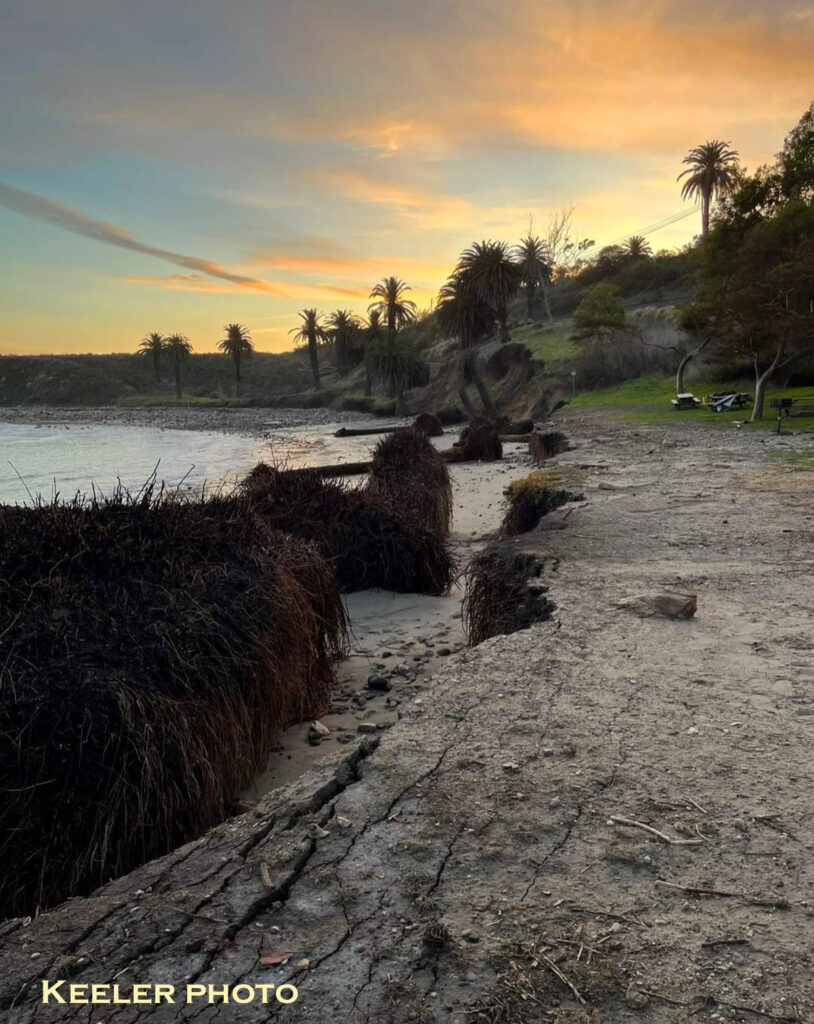
Without the palm’s root balls holding the lot on place, Mother Nature’s gonna be coming in hard and fast .
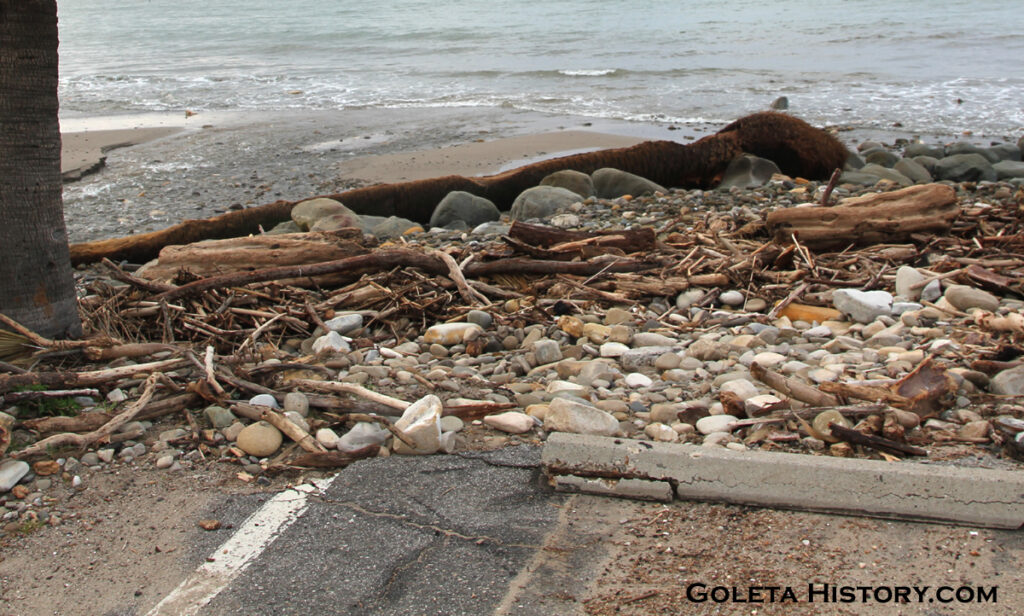
And having no parking lot will impact the state financially, so you can bet they will find the funding to fix that.
So when the park re-opens, you might want to go up and take a long look at the remaining Refugio Palms. Soak up the beauty. Take pictures. Enjoy them.
And try to imagine all the changes they’ve been a witness to. If these palms could talk….
When young Nelson Rutherford planted these trees in the late 1920’s he probably never dreamed they would still be standing 100 years later.
Thanks Nelson.
Here’s a link to the Refugio State Beach official page.
Also links to artists Tom DeWalt, Chris Potter, Jeffrey Campbell.
Sources: Santa Barbara News Press, John Wilkens, Wikipedia, Walker Tompkins, UCSB, www.orellaranch.com, Tommy Keeler, Mark Sanchez, Santa Barbara Independent, Chris Dale, Edhat, Richard Michael Fisher, Tom DeWalt, Chris Potter, Santa Barbara Historical Museum, and very special thanks to Michael Redmon.
























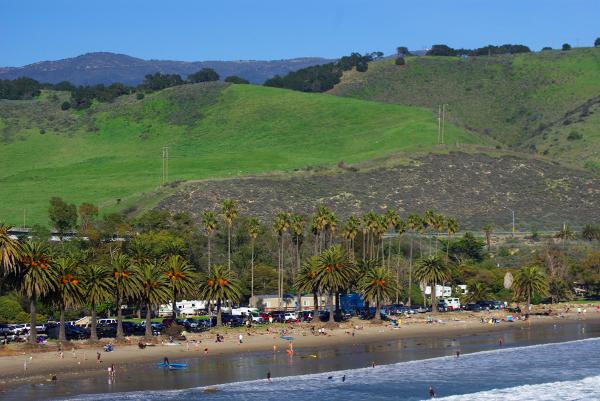
























The palms at Refugio beach have lots of years left to live, and moving them inland away from the encroaching surfline is the moral and responsible thing to do.
They are an iconic part of many visitors’ and locals’ memories of Santa Barbara, and deserve to remain.
You are absolutely correct that without their rootball buffer the parking lot will be eroded, and THEN the State will allocate the funds.
Palms like this go for seriously big bucks to landscapers, I am amazed that they didn’t allow salvaging of the ones that have fallen, which could fund responsible care and moving more inland.
Thank you for this informative and bittersweet ode to a much loved and precious spot. Such history these palms have witnessed. In this neck of the woods, where homeowners move palm trees like furniture, doesn’t it make sense to save these beauties? I’ll be adding my support to the list, using your helpful links.
Who moves palms like furniture?!!
Let me know, they can have mine for free!
The birds planted them. They’re at least 2 stories tall. Free for the taking!
Read the story. Birds didn’t plant them. And people do move trees like furniture.
I did read your story. It’s a great piece of work as always.
Read my comment: I did not say birds planted the Refugio Palms, I said they planted mine.
I called around to SB arborists and I no one showed any interest in free large healthy palms. They can’t be given away.
Gotcha.
I added more links to this page on my website after it went to edhat.
Here’s a link to Gregg Hart’s email. See if he cares –
https://a37.asmdc.org/contact
Here’s an historic video of the palms falling-
https://youtu.be/F_cq_3WhpUc?si=1utUR50qk0Vtxg2i
tMo you’ve done it again! Beautiful and engaging photo story. That station wagon parked on the beach could’ve been my dad’s. He loved that place for surfing and bringing up abalone for dinner.
Thanks for providing us with this interesting and touching story.
What about the train tracks. At the far end of the beach with these trees falling
“These palms are not hard to transplant, and Mother Nature has done most the work already, exposing the majority of the root ball. But in these days of budget cuts and deep deficits, the chance of these palms getting saved is slim to none.”
Where are you going to put them? You’re great with photo documentation, you could post a photo highlighting their new home.
Who is paying for the crane work and horticulture?
Why so certain they’ll survive transplant?
What is their life span after transplant?
Life goes on. It always includes death.
Montecito’s flood basin are being cleaned out, storm after storm. That material is being trucked to Goleta beach. It’s called beach replenishment. Lot of people that Love Goleta Beach are upset over this.
Why don’t they just truck all this storm debris up here?
John Comer has also painted those palms, more than once. Thanks for the story, wonderful as usual. And thanks for the links to the powers that be. Will be writing!
They are not native – I thought we are letting these things go?
So help me understand this popular argument. We should only have native plants in our environment? Why?
While moving the palms is a possibility it would mean moving the parking area too. A better solution is and has been available for years. Debry basins have been in place behind Montecito for several years and need to be cleaned after any heavy rain events. Lately the rock and sand has been dumped at Goleta Beach or hauled over to the Santa Ynez Valley. Why it hasn’t been used to protect the palms at Refugio is a mystery to me. Even when parts of Refugio Road were covered with washed out boulders during the last few years the material was hauled away instead of being placed at Refugio Beach.